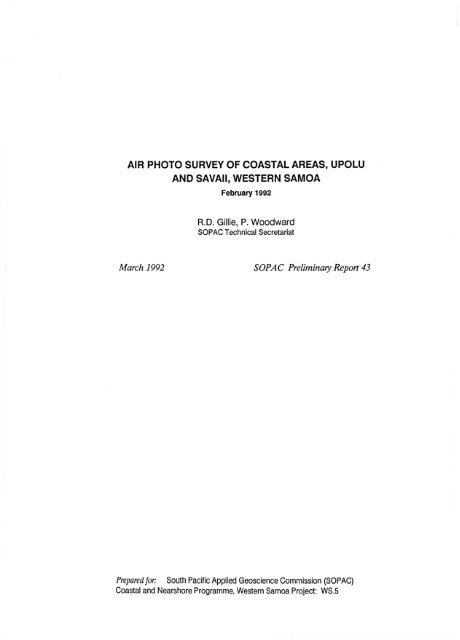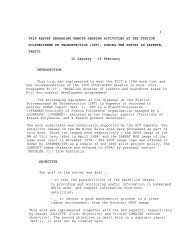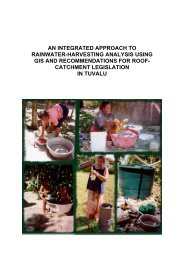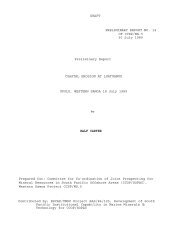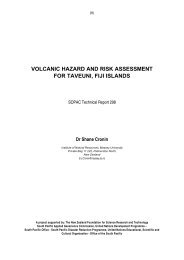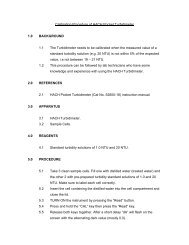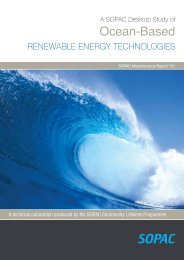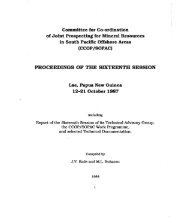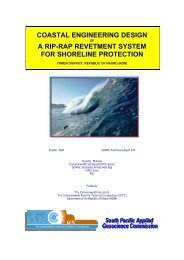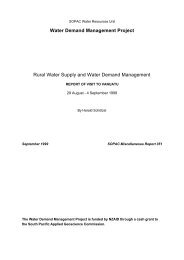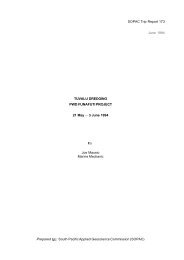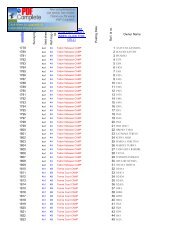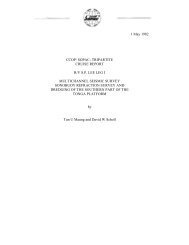Air photo survey of coastal areas, Upolu and Savaii, Western Samoa ...
Air photo survey of coastal areas, Upolu and Savaii, Western Samoa ...
Air photo survey of coastal areas, Upolu and Savaii, Western Samoa ...
Create successful ePaper yourself
Turn your PDF publications into a flip-book with our unique Google optimized e-Paper software.
AIR PHOTO SURVEY OF COASTAL AREAS, UPOLU<br />
AND SAVAII, WESTERN SAMOA<br />
February 1992<br />
RD. Gillie, P. Woodward<br />
SOPAC Technical Secretariat<br />
March 1992 SOPAC Preliminary Report 43<br />
Prepared for: South Pacific Applied Geoscience Commission (SOPAC)<br />
Coastal <strong>and</strong> Nearshore Programme. <strong>Western</strong> <strong>Samoa</strong> Project: WS.5
[3]<br />
TABLE OF CONTENTS<br />
Page<br />
SUMMARy 5<br />
ACKNOWLEDGEMENTS . . . . . . . . . . . . . . . . . . . . . . . . . . . . . . . . . . . . . . . . . . . . . . . . . . . .. 6<br />
INTRODUCTION . . . . . . . . . . . . . . . . . . . . . . . . . . . . . . . . . . . . . . . . . . . . . . . . . . . . . . . . . .. 7<br />
OBJECTIVES 7<br />
METHODS, EQUIPMENT AND OPERATIONS 8<br />
Flight Planning 8<br />
Survey <strong>Air</strong>craft 10<br />
Camera <strong>and</strong> Film 11<br />
Camera Frame 11<br />
PRELIMINARY RESULTS 13<br />
REFERENCES 18<br />
APPENDICES<br />
LOG OF FIELD ACTIVITIES 19<br />
2 PERSONNEL PARTICIPATING IN SURVEY 21<br />
[LR43 - Gillie & Woodward]
[4]<br />
LIST OF FIGURES<br />
Figures Page<br />
Oblique view from rear door <strong>of</strong> aircraft <strong>of</strong> the north coast<br />
<strong>of</strong> <strong>Upolu</strong> 9<br />
2 Britten-Norman Isl<strong>and</strong>er aircraft chartered from Polynesian<br />
<strong>Air</strong>lines for the air <strong>photo</strong> <strong>survey</strong> 10<br />
3 Camera mounted outside <strong>of</strong> the rear door <strong>of</strong> the aircraft 12<br />
4 Location <strong>of</strong> air <strong>photo</strong> <strong>survey</strong> <strong>areas</strong> on <strong>Upolu</strong> 14<br />
5 Location <strong>of</strong> air <strong>photo</strong> <strong>survey</strong> <strong>areas</strong> on Savai'i 15<br />
LIST OF TABLES<br />
Tables Page<br />
<strong>Air</strong> Photo Survey Parameters . . . . . . . . . . . . . . . . . . . . . . . . . . . . . . . . . . . . .. 9<br />
2 Camera <strong>and</strong> Film Specifications 12<br />
3 Summary <strong>of</strong> <strong>Air</strong> Photo Survey Lines on <strong>Upolu</strong> 16<br />
4 Summary <strong>of</strong> <strong>Air</strong> Photo Survey Lines on Savai'i 17<br />
[LR43 - Gillie & Woodward]
SUMMARY<br />
At the request <strong>of</strong> the Government <strong>of</strong> <strong>Western</strong> <strong>Samoa</strong>, personnel from the SOPAG<br />
Technical Secretariat conducted a vertical air <strong>photo</strong> <strong>survey</strong> <strong>of</strong> portions <strong>of</strong> the isl<strong>and</strong>s <strong>of</strong> <strong>Upolu</strong> <strong>and</strong><br />
Savai'i over the four days 19-22 February 1992. The air <strong>photo</strong> <strong>survey</strong> was conducted primarily to<br />
assist the Government <strong>of</strong> <strong>Western</strong> <strong>Samoa</strong> with recovery operations associated with the serious<br />
damage <strong>of</strong> <strong>coastal</strong> <strong>areas</strong> caused by cyclone Val in December 1991. In particular. the <strong>areas</strong> to be<br />
<strong>survey</strong>ed were requested after consultation with various government departments, particularly<br />
Public Works <strong>and</strong> L<strong>and</strong>s <strong>and</strong> Environment. Areas were selected for <strong>survey</strong> for a variety <strong>of</strong> reasons<br />
including: cyclone damage assessment, road reconstruction planning, assessment <strong>of</strong> existing <strong>and</strong><br />
proposed nearshore s<strong>and</strong> mining sites, <strong>coastal</strong> environment conservation <strong>and</strong> tourism<br />
development planning. During the <strong>survey</strong> SOPAG personnel were assisted by staff from L<strong>and</strong>s <strong>and</strong><br />
the Environment <strong>and</strong> the Apia Observatory.<br />
The air <strong>photo</strong> <strong>survey</strong> was conducted using the SOPAG aerial <strong>photo</strong> camera (Hasselblad<br />
553 ELX) which was mounted in a Britten-Norman Isl<strong>and</strong>er under local charter from Polynesian<br />
<strong>Air</strong>lines at Faleolo <strong>Air</strong>port. During the four days <strong>of</strong> suitable weather for aerial <strong>photo</strong>graphy, 6 1/2<br />
hours <strong>of</strong> flying time were needed to <strong>photo</strong>graph approximately 150 km <strong>of</strong> coastline. A total <strong>of</strong> 376<br />
colour <strong>photo</strong>graphs were obtained, each <strong>photo</strong>graph covering a ground area <strong>of</strong> approximately 600<br />
x 600 metres.<br />
The rolls <strong>of</strong> negative film have been sent to Melbourne, Australia for developing <strong>and</strong><br />
printing <strong>of</strong> contact pro<strong>of</strong>s. Upon their return to SOPAG, colour <strong>photo</strong>graphs will be printed locally<br />
in Fiji at a scale <strong>of</strong> approximately 1:3,000 to provide high resolution images <strong>of</strong> nearshore <strong>and</strong><br />
<strong>coastal</strong> features. A subsequent SOPAG report will document in detail the air <strong>photo</strong> <strong>survey</strong> track<br />
lines <strong>and</strong> series <strong>of</strong> <strong>photo</strong>graphs obtained. This air <strong>photo</strong> <strong>survey</strong> documentation report along with<br />
two sets <strong>of</strong> prints <strong>of</strong> the air <strong>photo</strong>s will be available to the Government <strong>of</strong> <strong>Western</strong> <strong>Samoa</strong> in<br />
approximately one month (April 1992).<br />
[LR43 - Gillie & Woodward]
[6]<br />
ACKNOWLEDGEMENTS<br />
This work was carried out at the request <strong>of</strong> the Government <strong>of</strong> <strong>Western</strong> <strong>Samoa</strong>. While<br />
conducting field work in <strong>Western</strong> <strong>Samoa</strong> the support <strong>of</strong> the following personnel was greatly<br />
appreciated:<br />
Steve Kamu<br />
Sam Toape<br />
Leo'o Polutea<br />
- Acting Superintendent, Apia Observatory<br />
- Field Assistant/Driver, Apia Observatory<br />
- Chief Photogrammetist, Department <strong>of</strong> L<strong>and</strong>s <strong>and</strong> Environment<br />
Funds for this project were contributed by the New Zeal<strong>and</strong> Government, the International<br />
Centre for Ocean Development (ICOD), Canada; the Australian International Development<br />
Assistance Bureau (AIDAB); <strong>and</strong> the UNDP /ESCAP RAS/86/125.<br />
[LR43 - Gillie & Woodward]
[7]<br />
INTRODUCTION<br />
SOPAC has been requested to do a number <strong>of</strong> work tasks in <strong>Western</strong> <strong>Samoa</strong> associated<br />
with <strong>coastal</strong> <strong>areas</strong>, including problems associated with damage from cyclone Ofa in 1990 (Rearic<br />
1990), <strong>coastal</strong> resource mapping <strong>and</strong> management (Richmond 1991a, 1991b, 1991c, 1991d) <strong>and</strong><br />
<strong>coastal</strong> erosion associated with nearshore mining <strong>of</strong> s<strong>and</strong> (Carter 1987, 1990, 1991; Holden 1991).<br />
Most <strong>of</strong> these tasks have required the use <strong>of</strong> air <strong>photo</strong>s <strong>and</strong> have recommended further historical<br />
shoreline analysis using air <strong>photo</strong>graphs to identify rates <strong>and</strong> potential causes <strong>of</strong> shoreline erosion.<br />
Following cyclone Val in December, 1991 the SOPAC Governing Council endorsed an air<br />
<strong>photo</strong> <strong>survey</strong> <strong>of</strong> <strong>Western</strong> <strong>Samoa</strong> as being particularly relevant since such a <strong>survey</strong> would have<br />
multipurpose objectives, all aimed at assisting with <strong>coastal</strong> development <strong>and</strong> management.<br />
In early February, 1992 the SOPAC Deputy Director (Mr Jim Eade) visited <strong>Western</strong> <strong>Samoa</strong><br />
to discuss priority <strong>areas</strong> for an air <strong>photo</strong> <strong>survey</strong>. During the week <strong>of</strong> 17-23 February a SOPAC<br />
team comprising a Coastal Geologist (Dr Rick Gillie), Chief Cartographer (Mr Phil Woodward) <strong>and</strong><br />
Electronics Technician (Mr Peni Musunamasi) visited <strong>Western</strong> <strong>Samoa</strong> to conduct the air <strong>photo</strong><br />
<strong>survey</strong>. A log <strong>of</strong> field activities during the week is contained in Appendix 1. Personnel from the<br />
Government <strong>of</strong> <strong>Western</strong> <strong>Samoa</strong> also took part in the <strong>survey</strong> (Appendix 2).<br />
OBJECTIVES<br />
This work task was undertaken as part <strong>of</strong> Project WS.5: "Coastal Development Studies".<br />
The specific objective <strong>of</strong> the air <strong>photo</strong> <strong>survey</strong> was to obtain low level, colour air <strong>photo</strong>graphs for<br />
segments <strong>of</strong> the <strong>Upolu</strong> <strong>and</strong> Savai'i coastlines. The priority <strong>areas</strong> were defined as follows:<br />
(1) northern <strong>Upolu</strong>, especially around Apia <strong>and</strong> to the east <strong>and</strong> west where the road is<br />
immediately adjacent to the coast;<br />
(2) northwest <strong>and</strong> north Savai'i, again where the road follows the coast <strong>and</strong> where cyclone<br />
damage was especially bad as a result <strong>of</strong> cyclone Val;<br />
(3) eastern Savai'i where s<strong>and</strong> resources suitable for roading have been identified by SOPAC;<br />
(4) the area around Mulifanua Wharf on western <strong>Upolu</strong> where there has been dredging <strong>and</strong><br />
there are problems with siltation <strong>and</strong> erosion;<br />
[LR43 - Gillie & Woodward]
[8]<br />
(5) Aleipata wharf area on eastern <strong>Upolu</strong> were s<strong>and</strong> resources suitable for roading have been<br />
identified by SOPAG.<br />
The <strong>areas</strong> were chosen taking into account the formal requests from SOPAG's <strong>of</strong>ficial<br />
contacts in <strong>Western</strong> <strong>Samoa</strong> (Foreign Affairs <strong>and</strong> the Apia Observatory) <strong>and</strong> informal discussions in<br />
early February between the SOPAG Deputy Director <strong>and</strong> <strong>of</strong>ficers <strong>of</strong> Public Works <strong>and</strong> L<strong>and</strong>s <strong>and</strong><br />
Environment.<br />
METHODS, EQUIPMENT AND OPERATIONS<br />
Prior to the <strong>survey</strong> team arriving in <strong>Western</strong> <strong>Samoa</strong>, the SOPAG Deputy Director had<br />
made a visit to the country to identify suitable target <strong>areas</strong> for the <strong>survey</strong> <strong>and</strong> a local aircraft to<br />
conduct the <strong>survey</strong>. The results <strong>of</strong> this initial visit were very useful. In particular, the identification<br />
<strong>and</strong> priority attached to proposed <strong>survey</strong> <strong>areas</strong> simplified anyon-site decisions. The availability <strong>of</strong><br />
the Britten-Norman Isl<strong>and</strong>er aircraft was ideal for the intended <strong>survey</strong>. A general description <strong>of</strong> the<br />
SOPAG vertical aerial <strong>photo</strong>graphy capability is contained in Gillie (1991). The following methods,<br />
equipment <strong>and</strong> operations were used in the <strong>Western</strong> <strong>Samoa</strong> <strong>survey</strong>.<br />
Flight Planning<br />
On 18 February the weather was unfavourable for any type <strong>of</strong> flying with heavy rain <strong>and</strong><br />
low clouds. A meeting at the Polynesian <strong>Air</strong>line's hangar between the SOPAG team <strong>and</strong> Polynesian<br />
staff confirmed that the camera frame <strong>and</strong> safety harness for the camera operator were<br />
acceptable.<br />
The parameters <strong>of</strong> the air <strong>photo</strong> <strong>survey</strong>, such as flying height, <strong>photo</strong> scale, etc were<br />
determined before h<strong>and</strong>. These are summarised in Table 1.<br />
Prior to each day's <strong>survey</strong>, flight lines were drawn on suitable maps at 1:25,000 or<br />
1:20,000 scale. Before each flight the pilot was briefed on the area to be covered <strong>and</strong> an estimate<br />
was made <strong>of</strong> the time required to undertake the <strong>survey</strong>. In some cases, weather conditions caused<br />
<strong>survey</strong> activities to be aborted early. Weather problems arose because <strong>of</strong> low clouds, rain <strong>and</strong><br />
turbulent cloud formations (Figure 1).<br />
[LR43 - Gillie & Woodward]
Table 1. <strong>Air</strong> Photo Survey Parameters.<br />
<strong>Air</strong>craft Flying Parameters<br />
Flying Height<br />
Flying Speed<br />
Photo Ground Coverage<br />
Distance Between Photos for 30% Endlap<br />
Interval Between Photos<br />
Negative <strong>and</strong> Photo Enlargement Parameters<br />
Negative Size<br />
Negative Scale<br />
Enlargement Size<br />
Enlargement Scale<br />
Summary Statistics<br />
Flying time<br />
Total Number <strong>of</strong> Photos<br />
Total Length <strong>of</strong> Coastline Photographed<br />
[9]<br />
3,500 feet (1,067 metres)<br />
100 knots<br />
589 x 589 metres<br />
421 metres<br />
8 seconds<br />
55 x 55 millimetres<br />
1:10,670<br />
203 x 203 mm (8 x 8 inches)<br />
1:2,891<br />
6 hours, 33 minutes<br />
376<br />
150 km<br />
FlQure 1. Oblique view from rear door <strong>of</strong> aircraft <strong>of</strong> the north coast <strong>of</strong> <strong>Upolu</strong> with the Mulinu'u Peninsula <strong>and</strong> Apia in the<br />
middle distance <strong>of</strong> the <strong>photo</strong>. The cloud base is at approximately 2,500 feet, which is below the design flying height <strong>of</strong><br />
3,500 feet, but the clouds are mostly located inl<strong>and</strong> <strong>and</strong> do not obscure the coastline.<br />
[LR43 - Gillie & Woodward]
[10]<br />
The importance <strong>of</strong> navigation was discussed in detail with the pilot. During the <strong>survey</strong> Dr<br />
Rick Gillie <strong>and</strong> Mr Phil Woodward alternated in the role as navigator <strong>and</strong> sat in the co-pilot seat to<br />
assist the pilot. A head set was provided for communications with the pilot. The camera was<br />
operated by either Mr Peni Musunamasi or Mr Leo'o Polutea. Communications regarding the start<br />
<strong>and</strong> end <strong>of</strong> a <strong>survey</strong> line <strong>and</strong> the number <strong>of</strong> <strong>photo</strong>graphs to be taken on a line were made by the<br />
navigator to the camera operator using a raised h<strong>and</strong> signal <strong>and</strong> numbered card. This proved to<br />
be quite simple <strong>and</strong> reliable. However, future <strong>survey</strong>s would benefit from an additional head set for<br />
communications with the camera operator.<br />
Survey <strong>Air</strong>craft<br />
The Britten-Norman Isl<strong>and</strong>er is a twin engine aircraft (Figure 2) <strong>and</strong> is considered<br />
necessary for over water operations. It is commonly used in South Pacific isl<strong>and</strong> countries<br />
Rgure 2. Britten-Norman Isl<strong>and</strong>er aircraft chartered from Polynesian <strong>Air</strong>lines for the air <strong>photo</strong> <strong>survey</strong>. The camera is<br />
mounted outside <strong>of</strong> the rear door <strong>of</strong> the aircraft.<br />
[LR43 - Gillie & Woodward]<br />
'.
[11]<br />
because <strong>of</strong> its short take <strong>of</strong>f <strong>and</strong> l<strong>and</strong>ing capabilities. The aircraft can be flown safely at a speed <strong>of</strong><br />
100 knots with the rear door removed <strong>and</strong> its size <strong>of</strong>fers greater stability over smaller aircraft <strong>and</strong><br />
helicopters. Wind disturbance <strong>and</strong> noise in the interior rear <strong>of</strong> the aircraft was not a serious<br />
problem, although it is usually necessary for the camera operator to wear a light jacket <strong>and</strong> pants<br />
to prevent becoming chilled by the wind.<br />
A safety harness comprising a body harness, short length <strong>of</strong> rope <strong>and</strong> locking hook which<br />
is attached to the seat frame is worn by the camera operator at all times. He is also secured by<br />
the aircraft seat lap belt. The safety harness is considered to be an essential item when the door<br />
<strong>of</strong> the aircraft is removed. The camera operator only needs to release the seat lap belt to raise <strong>and</strong><br />
lower the camera mount <strong>and</strong> to change film magazines. During this period the safety harness<br />
restrains the operator from reaching the door.<br />
Camera <strong>and</strong> Film<br />
Details <strong>of</strong> the camera <strong>and</strong> film used are contained in Table 2. The camera has a motor<br />
drive <strong>and</strong> remote shutter release to advance the film. Each film magazine provides for up to 70<br />
<strong>photo</strong>graphs. Each magazine contains a loaded <strong>and</strong> takeup film cassette. SOPAC presently has<br />
three film magazines allowing for up to 200 <strong>photo</strong>graphs during a flight. Additional film cassettes<br />
are available for re-Ioading magazines each day.<br />
The camera was operated at its fastest shutter speed <strong>of</strong> 1/500 second. An aperture <strong>of</strong> f/4<br />
was used for dull conditions (high overcast) <strong>and</strong> f/5.6 for bright conditions (full sun).<br />
The film is only available from Australia or the United States in bulk rolls (30 metres) <strong>and</strong> is<br />
designed for aerial <strong>photo</strong>graphy purposes. The film is developed in Australia <strong>and</strong> contact pro<strong>of</strong>s<br />
are also printed there. After receipt <strong>of</strong> the negatives <strong>and</strong> contact pro<strong>of</strong>s at SOPAC, printing <strong>of</strong><br />
enlargements at a scale <strong>of</strong> 1:3,000 can be done in Suva.<br />
Camera Frame<br />
The camera frame is mounted to the floor <strong>and</strong> projects through the rear door opening <strong>of</strong><br />
the aircraft (Figure 3). The frame actually consists <strong>of</strong> two parts: a floor frame which is designed to<br />
fit to the seat mounts <strong>of</strong> the Isl<strong>and</strong>er aircraft <strong>and</strong> the camera mount which has adjustments to level<br />
[LR43 - Gillie & Woodward]
Table 2. Camera <strong>and</strong> Film Specifications<br />
Camera Hasselblad model 553 ELX, with motor drive <strong>and</strong> 1.5 m remote<br />
shutter release cord<br />
[12]<br />
lens Zeiss, 100 mm Planar CF, f/3.5<br />
Settings Shutter = 1/500 sec<br />
Aperture = f/4 (dull) - f/5.6 (bright)<br />
Negative Format 55 x 55 mm (2 1/4 x 2 1/4 inches)<br />
Film Magazine Roll film magazine 70<br />
Film Type KODAK AEROCOlOUR Negative Film 2445 Estar base, fine-grain<br />
colour-negative film for <strong>photo</strong>grammetric <strong>and</strong> general aerial use.<br />
Effective aerial film speed: 100. Purchased as 30 m rolls <strong>and</strong><br />
loaded into 70 frame Hasselblad cassettes.<br />
Film Purchase Caines Photographic Distributors, Suva, Fiji Isl<strong>and</strong>s<br />
Film Developing United Photo <strong>and</strong> Graphic Services P/l, Factory 4/2 Apollo Court<br />
P.O. Box 407, Blackburn 3130, Australia<br />
Figure 3. Camera mounted outside <strong>of</strong> the rear door <strong>of</strong> the aircraft. The frame is bolted to the rear seat mounts. The<br />
frame includes vertical adjustments to level the camera <strong>and</strong> a hinge to allow the camera to be withdrawn into the aircraft<br />
for film magazine changes.<br />
[lR43 - Gillie & Woodward]
[13]<br />
the camera. It is also possible to hinge the camera mount portion <strong>of</strong> the frame into the aircraft for<br />
take <strong>of</strong>f <strong>and</strong> l<strong>and</strong>ings <strong>and</strong> to change film magazines.<br />
As the camera projects outside <strong>of</strong> the aircraft, it is not possible to site through the camera<br />
at the ground. However, it is eventually hoped to be able to use a small video camera <strong>and</strong> monitor<br />
to confirm <strong>photo</strong>graph coverage while conducting the <strong>survey</strong>.<br />
PRELIMINARY RESULTS<br />
A summary <strong>of</strong> the <strong>areas</strong> <strong>and</strong> <strong>survey</strong> lines completed are contained in Tables 3 <strong>and</strong> 4,<br />
respectively for the isl<strong>and</strong>s <strong>of</strong> <strong>Upolu</strong> <strong>and</strong> Savai'i. The locations <strong>of</strong> the air <strong>photo</strong> <strong>survey</strong> <strong>areas</strong> are<br />
shown in Figures 4 <strong>and</strong> 5.<br />
In total, during the four days <strong>of</strong> suitable weather for aerial <strong>photo</strong>graphy, 6 1/2 hours <strong>of</strong><br />
flying time were needed to <strong>photo</strong>graph approximately 150 km <strong>of</strong> coastline. A total <strong>of</strong> 376 colour<br />
<strong>photo</strong>graphs were obtained during the <strong>survey</strong>. Each <strong>photo</strong>graph covers a ground area <strong>of</strong><br />
approximately 600 x 600 metres.<br />
It is expected that the majority <strong>of</strong> <strong>photo</strong>graphs will be on the target line <strong>and</strong> suitable for<br />
enlargement. However, it is also expected that some will not be suitable for further use, either<br />
being over water or inl<strong>and</strong> <strong>of</strong> the shoreline. On some lines clouds may also have obscured some<br />
<strong>of</strong> the ground images. All <strong>of</strong> the potential <strong>photo</strong>graphs will be evaluated by examination <strong>of</strong> the<br />
contact pro<strong>of</strong>s. A final list <strong>of</strong> frames suitable for enlargement <strong>and</strong> printing will then be prepared. In<br />
addition, a report documenting all <strong>survey</strong> <strong>areas</strong>, track lines <strong>and</strong> <strong>photo</strong>graphs will be prepared with<br />
accompanying maps at a scale 1:20,000 to properly document <strong>and</strong> archive the results <strong>of</strong> the air<br />
<strong>photo</strong> <strong>survey</strong>. The documentation report along with two sets <strong>of</strong> prints <strong>of</strong> the air <strong>photo</strong>s will be sent<br />
to the Government <strong>of</strong> <strong>Western</strong> <strong>Samoa</strong>. The negatives, contact prints <strong>and</strong> one set <strong>of</strong> prints will be<br />
archived at SOPAC in their <strong>Air</strong> Photo Library.<br />
[LR43 - Gillie & Woodward]
~<br />
Z ._==----l\r----<br />
1=1<br />
~<br />
ILl<br />
a::<br />
~<br />
[14]<br />
Rgure 4. location <strong>of</strong> air <strong>photo</strong> <strong>survey</strong> <strong>areas</strong> on <strong>Upolu</strong>. Refer to Table 3 for <strong>survey</strong> lines in each area.<br />
[LR43 - Gillie & Woodward]<br />
••<br />
Q<br />
o
H<br />
[16]<br />
Table 3. Summary <strong>of</strong> <strong>Air</strong> Photo Survey Lines on <strong>Upolu</strong>.<br />
AREA I<br />
AREA II<br />
AREA III<br />
AREA IV<br />
Area <strong>and</strong> Lines Number <strong>of</strong> Frames<br />
Mulifanua Wharf, Line 1<br />
Mulifanua Wharf, Line 2<br />
Mulifanua Wharf, Line 3<br />
N<strong>of</strong>oali'j<br />
Fasito'outa<br />
Tufulele<br />
Sale'imoa, Line 1<br />
Sale'imoa, Line 2<br />
Afega, Line 1<br />
Afega, Line 2<br />
Apia Concrete, Line 1<br />
Apia Concrete, Line 2<br />
Mulinu'u Peninsula, Line 1<br />
Mulinu'u Peninsula, Line 2<br />
Apia Harbour, Line 1<br />
Apia Harbour, Line 2<br />
Moata'a, Line 1<br />
Moata'a, Line 2<br />
Apia East<br />
Vailele<br />
Letogo<br />
Lauli'i<br />
Luatuanu'u, Line 1<br />
Luatuanu'u, Line 2<br />
Satitoa, Line 1<br />
Satitoa, Line 2<br />
--------------------------------------------------------- ....._------------ ..------------------------------ .._ .•.<br />
[LR43 - Gillie & Woodward]<br />
7<br />
9<br />
12<br />
8<br />
8<br />
10<br />
10<br />
16<br />
16<br />
9<br />
9<br />
6<br />
7<br />
8<br />
9<br />
7<br />
5<br />
7<br />
6<br />
14<br />
14<br />
6<br />
6<br />
6<br />
5<br />
5
[17]<br />
Table 4. Summary <strong>of</strong> <strong>Air</strong> Photo Survey Lines on Savai'i.<br />
AREA I<br />
AREA II<br />
AREA III<br />
AREA IV<br />
Area <strong>and</strong> Lines<br />
Falealupo<br />
Cape Vaitoloa<br />
Papa<br />
Sataua<br />
Vaisala<br />
Auala<br />
Asau<br />
Fagae'e<br />
Samauga<br />
Safotu<br />
Manase<br />
Lelepa<br />
Sato'alepai, Line 1<br />
Sata'olepal, Line 2<br />
Pu'apu'a, Line 1<br />
Pu'apu'a. Line 2<br />
Lano<br />
Sa'asa'ai<br />
Faga<br />
Sapapali'i<br />
'Iva<br />
[LR43 - Gillie & Woodward]<br />
Number <strong>of</strong> Frames<br />
10<br />
6<br />
8<br />
6<br />
7<br />
6<br />
6<br />
10<br />
7<br />
8<br />
6<br />
5<br />
9<br />
5<br />
6<br />
6<br />
10<br />
6<br />
9<br />
10<br />
5
[18]<br />
REFERENCES<br />
Carter, A. 1987: Design <strong>of</strong> the seawall for Mulinu'u Point, Apia, <strong>Western</strong> <strong>Samoa</strong>. CCOP/SOPAC<br />
Technical Report 78: 18 pages; 10 figures; 4 tables.<br />
Carter, A. 1990: The proposed central bank building site in Apia: preliminary comments. SOPAC<br />
Preliminary Report 19: 5 pages.<br />
Carter, A. 1991:Shoreline erosion on Mulinu'u Point <strong>and</strong> related considerations in <strong>Western</strong> <strong>Samoa</strong>.<br />
SOPAC Technical Report 118: 21 pages.<br />
Gillie, A.D. 1991: Field demonstration <strong>of</strong> vertical aerial <strong>photo</strong>graphy capability, western Viti Levu.<br />
Fiji, 30 May, 1991. SOPAC Preliminary Report 34: 23 pages.<br />
Holden, B. 1991: Shoreline erosion <strong>and</strong> related problems, <strong>Western</strong> <strong>Samoa</strong>. SOPAC Preliminary<br />
Report 28: 8 pages.<br />
Rearic, D.M. 1990: Survey <strong>of</strong> cyclone Ofa damage to the northern coast <strong>of</strong> <strong>Upolu</strong>, <strong>Western</strong><br />
<strong>Samoa</strong>. SOPAC Technical Report 104: 34 pages.<br />
Richmond, B.M. 1991a: Coastal morphology, shoreline stability, <strong>and</strong> nearshore mineral resources<br />
<strong>of</strong> <strong>Upolu</strong>, <strong>Western</strong> <strong>Samoa</strong>. SOPAC Technical Report 90: 81 pages.<br />
Richmond, B.M. 1991b: Coastal geology <strong>of</strong> <strong>Upolu</strong>, <strong>Western</strong> <strong>Samoa</strong>. In Keating, B.H. <strong>and</strong> Bolton,<br />
B.A., editors: Geology <strong>and</strong> Offshore Mineral Resources <strong>of</strong> the Central Pacific Basin: Circum-<br />
Pacific Council for Energy <strong>and</strong> Mineral Resources, Earth Science Series, v. 14. Springer-Verlag:<br />
New York.<br />
Richmond, B.M. 1991c: Coastal Morphology <strong>of</strong> <strong>Western</strong> <strong>Samoa</strong>: 1:25,000 SOPAC Coastal Map<br />
Series (Maps 1A - 10).<br />
Richmond, B.M. 1991d: Notes to accompany 1:25,000 Coastal Morphology Maps <strong>of</strong> <strong>Western</strong><br />
<strong>Samoa</strong>. SOPAC Miscellaneous Report 111: 11 pages.<br />
[LR43 - Gillie & Woodward]
18 FEBRUARY 1992 (Fiji)<br />
[19]<br />
APPENDIX 1<br />
LOG OF FIELD ACTIVITIES<br />
- Rick Gillie, Phil Woodward <strong>and</strong> Peni Musunamasi travel Suva to Nadi to Apia, <strong>Western</strong> <strong>Samoa</strong>.<br />
17 FEBRUARY 1992 (<strong>Western</strong> <strong>Samoa</strong>)<br />
- Met at Faleolo <strong>Air</strong>port, <strong>Western</strong> <strong>Samoa</strong> by Leo'o Polutea (Department <strong>of</strong> L<strong>and</strong>s <strong>and</strong><br />
Environment) <strong>and</strong> Sam Toape (Apia Observatory). Drive to Apia.<br />
- Meeting at Polynesian <strong>Air</strong>lines <strong>of</strong>fice with Shane Le Gale (Chief Domestic Pilot) to discuss flight<br />
planning <strong>and</strong> scheduling <strong>of</strong> aircraft use. The aircraft is available for SOPAC use between 10:00<br />
<strong>and</strong> 14:00 each day.<br />
- Check-in Hotel Kitano Tusitala.<br />
18 FEBRUARY 1992<br />
- Telephone call from Shane Le Gale (Isl<strong>and</strong>er Pilot) regarding flight planning. Weather is forecast<br />
as rain showers for the day. Arrange to meet at airport hanger at 12:00 anyway.<br />
- Visit to L<strong>and</strong>s <strong>and</strong> Environment. Examine Hasselblad camera owned by L<strong>and</strong>s <strong>and</strong> review<br />
additional components (motor drive, remote shutter release) required to conduct air <strong>photo</strong><br />
<strong>survey</strong>s<br />
- Visit to Apia Observatory<br />
- Meet with Isl<strong>and</strong>er Pilot at airport hanger. Moderate rain showers <strong>and</strong> low cloud ceiling.<br />
Demonstrate use <strong>of</strong> camera, mounting frame <strong>and</strong> safety harness in hanger. Arrange for<br />
telephone call each morning from pilot to plan day's activities.<br />
- Return to Tusitala. Moderate rain <strong>and</strong> low clouds for rest <strong>of</strong> day.<br />
19 FEBRUARY 1992<br />
- Rain has ended <strong>and</strong> weather improved. Mostly high overcast <strong>and</strong> calm.<br />
- Arrive airport mid-morning <strong>and</strong> install camera frame <strong>and</strong> camera. Run through air <strong>photo</strong><br />
procedures with SOPAC personnel <strong>and</strong> pilot. Review flight plan with pilot.<br />
- Conduct air <strong>photo</strong> <strong>survey</strong> <strong>of</strong> north coast <strong>of</strong> <strong>Upolu</strong> east <strong>of</strong> Faleolo <strong>Air</strong>port between N<strong>of</strong>oali'i <strong>and</strong><br />
Sale'imoa, along Mulinu'u Peninsula in Apia <strong>and</strong> at Mulifanua Wharf at the west end <strong>of</strong> <strong>Upolu</strong>.<br />
Total flying time was 1:40.<br />
[LR43 - Gillie & Woodward]
20 FEBRUARY 1992<br />
- Weather high overcast. Plan to fly Savai'i <strong>areas</strong>. Request Administration Officer at Apia<br />
Observatory to make brief radio announcement to the public regarding the purpose <strong>of</strong> the<br />
Isl<strong>and</strong>er flights over Savai'i.<br />
[20]<br />
- Arrive airport. Isl<strong>and</strong>er not available until later. Decide to conduct air <strong>photo</strong> <strong>survey</strong> <strong>of</strong> remainder<br />
<strong>of</strong> north coast <strong>of</strong> <strong>Upolu</strong>. Heavy thundershow cloud build-up over Savai'j later in day.<br />
- Conduct air <strong>photo</strong> <strong>survey</strong> <strong>of</strong> coast east <strong>of</strong> Apia including Apia Harbour to Lauli'i. Also <strong>survey</strong><br />
east end <strong>of</strong> <strong>Upolu</strong> at Satitoa. Total flying time was 1:33.<br />
21 FEBRUARY 1992<br />
- Weather partly overcast. Plan to <strong>survey</strong> Savai'i.<br />
- Take-<strong>of</strong>f from airport at 10:45 <strong>and</strong> arrive west end <strong>of</strong> Savai'i approximately 11:15.<br />
- Survey portions <strong>of</strong> northwest, north <strong>and</strong> east coast <strong>of</strong> Savai'i. Total flying time was 2:20.<br />
22 FEBRUARY 1992<br />
- Weather mostly clear with less than 10% high cloud cover.<br />
- Survey remaining portions <strong>of</strong> north coast <strong>of</strong> <strong>Upolu</strong> east <strong>and</strong> west <strong>of</strong> Apia. Return to Faleolo<br />
<strong>Air</strong>port by south coast <strong>of</strong> <strong>Upolu</strong>. Total flying time was 1:00.<br />
23 FEBRUARY 1992<br />
- Return to Fiji late in day.<br />
[LR43 - Gillie & Woodward]
SOPAC Technical Secretariat<br />
Rick Gillie<br />
Phil Woodward<br />
Peni Musunamasi<br />
Government <strong>of</strong> <strong>Western</strong> <strong>Samoa</strong><br />
[21]<br />
APPENDIX 2<br />
PERSONNEL PARTICIPATING IN THE SURVEY<br />
Coastal Geologist<br />
Chief Cartographer<br />
Electronics Technician<br />
DEPARTMENT OF LANDS AND ENVIRONMENT<br />
Leo'o Polutea<br />
Godfrey Day<br />
APIA OBSERVATORY<br />
Steve Kamu<br />
Sam Toape<br />
Polynesian <strong>Air</strong>lines<br />
Senior Photogrammetrist<br />
Senior Surveyor<br />
Acting Superintendent<br />
Field Assistant/Driver<br />
Shane Le Gale Chief Domestic Pilot<br />
[LR43 - Gillie & Woodward]


